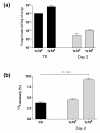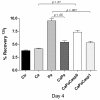Short term Candida albicans colonization reduces Pseudomonas aeruginosa-related lung injury and bacterial burden in a murine model
- PMID: 21689424
- PMCID: PMC3219024
- DOI: 10.1186/cc10276
Short term Candida albicans colonization reduces Pseudomonas aeruginosa-related lung injury and bacterial burden in a murine model
Abstract
Introduction: Pseudomonas aeruginosa is a frequent cause of ventilator-acquired pneumonia (VAP). Candida tracheobronchial colonization is associated with higher rates of VAP related to P. aeruginosa. This study was designed to investigate whether prior short term Candida albicans airway colonization modulates the pathogenicity of P. aeruginosa in a murine model of pneumonia and to evaluate the effect of fungicidal drug caspofungin.
Methods: BALB/c mice received a single or a combined intratracheal administration of C. albicans (1 × 10(5) CFU/mouse) and P. aeruginosa (1 × 10(7) CFU/mouse) at time 0 (T0) upon C. albicans colonization, and Day 2. To evaluate the effect of antifungal therapy, mice received caspofungin intraperitoneally daily, either from T0 or from Day 1 post-colonization. After sacrifice at Day 4, lungs were analyzed for histological scoring, measurement of endothelial injury, and quantification of live P. aeruginosa and C. albicans. Blood samples were cultured for dissemination.
Results: A significant decrease in lung endothelial permeability, the amount of P. aeruginosa, and bronchiole inflammation was observed in case of prior C. albicans colonization. Mortality rate and bacterial dissemination were unchanged by prior C. albicans colonization. Caspofungin treatment from T0 (not from Day 1) increased their levels of endothelial permeability and lung P. aeruginosa load similarly to mice receiving P. aeruginosa alone.
Conclusions: P. aeruginosa-induced lung injury is reduced when preceded by short term C. albicans airway colonization. Antifungal drug caspofungin reverses that effect when used from T0 and not from Day 1.
Figures





References
-
- Markowicz P, Wolff M, Djedaini K, Cohen Y, Chastre J, Delclaux C, Merrer J, Herman B, Veber B, Fontaine A, Dreyfuss D. Multicenter prospective study of ventilator-associated pneumonia during acute respiratory distress syndrome. Incidence, prognosis, and risk factors. ARDS Study Group. Am J Respir Crit Care Med. 2000;161:1942–1948. - PubMed
-
- Chastre J, Fagon JY. Ventilator-associated pneumonia. Am J Respir Crit Care Med. 2002;165:867–903. - PubMed
-
- el-Ebiary M, Torres A, Fabregas N, de la Bellacasa JP, González J, Ramirez J, del Baño D, Hernández C, Jiménez de Anta MT. Significance of the isolation of Candida species from respiratory samples in critically ill, non-neutropenic patients: an immediate post-mortem histologic study. Am J Respir Crit Care Med. 1997;156:583–590. - PubMed
MeSH terms
LinkOut - more resources
Full Text Sources

